You are using an out of date browser. It may not display this or other websites correctly.
You should upgrade or use an alternative browser.
You should upgrade or use an alternative browser.
Does anyone need premium Li-ion battery to DIY your solar system?
- Thread starter peter.w
- Start date
peter.w
New Member
- Joined
- May 16, 2020
- Messages
- 34
exactly, but product of this spec. is yet on the market. i know the road map.Welp, here's something that backs Peter up: Tesla may buy CATL'S Lithium Iron Phosphate Cobalt-Free Cells
View attachment 13517
@peter.w are you talking about selling this LifePO technology?
peter.w
New Member
- Joined
- May 16, 2020
- Messages
- 34
I agree with @Ryang.
My suggestion is to post prices for your batteries including shipping with the option of sea or air. Or set up a website for the "little" guys to order cells from. Surely you could be competitive with the other distributors considering the volume of cells you have. If you could throw in buss bars and bolts that would be a plus depending on the cost of the batteries. You could also offer smaller prebuilt packs with a built in BMS. In addition having some after sale support from you would be very valuable. I think everyone understands there will be a shipping cost. Just throwing out some suggestions. If you don't want to deal with it or can't for some reason I fully understand.
I appreciate your safety concerns. Thank you.
You could also offer smaller prebuilt packs with a built in BMS.
i think i will first provide something in this way, since my battery requires laser welding. within these days i will go to my factory and discuss with my team. it won't be difficult.
i will make 12V100Ah and 12V280Ah first, what do you say? i will post it here.
peter.w
New Member
- Joined
- May 16, 2020
- Messages
- 34
thanks for the suggestion. first i will make some sample and post it here, pls leave me sometime.Thanks. and to answer your previous logistics thoughts. Most here accept there is a shipping cost and build it into their calculations.
Quality and value is the foremost priority for many.
You could also offer smaller prebuilt packs with a built in BMS.
i think i will first provide something in this way, since my battery requires laser welding. within these days i will go to my factory and discuss with my team. it won't be difficult.
i will make 12V100Ah and 12V280Ah first, what do you say? i will post it here.
I like that idea but you might want to think about offering 24 volt as well. If the 12's can be connected in series that would work. Many here like to "know" their batteries so adding a smart BMS would be beneficial. Can studs be laser welded to your batteries for diy? Looking forward to what you come up with. No rush. Thank you for your considerations.
peter.w
New Member
- Joined
- May 16, 2020
- Messages
- 34
HI, Guys, just update here,
I just use laser welding to do the bundling (6 pcs in series 19.2V as required from one of my customer, showing here as a demo), as you can see, this is 100Ah CATL LFP battery, i leave major positive and negative ports for handy connecting.
i also leave a Nickel Plate on top of the busbar, as indicated by red arrow, there are 7 pcs of them at 7 different places for you to do general soldering wire of BMS.

I wrap them up with mylar film and properly protect the busbar
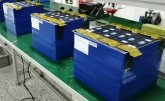
Does anyone interested in it? i will make 12V100Ah, 12V280Ah, 24V100Ah in next round.
12V100Ah in half way, since i just shut down the laser wielding machine and running out of the mylar.
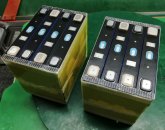
I just use laser welding to do the bundling (6 pcs in series 19.2V as required from one of my customer, showing here as a demo), as you can see, this is 100Ah CATL LFP battery, i leave major positive and negative ports for handy connecting.
i also leave a Nickel Plate on top of the busbar, as indicated by red arrow, there are 7 pcs of them at 7 different places for you to do general soldering wire of BMS.

I wrap them up with mylar film and properly protect the busbar

Does anyone interested in it? i will make 12V100Ah, 12V280Ah, 24V100Ah in next round.
12V100Ah in half way, since i just shut down the laser wielding machine and running out of the mylar.

peter.w
New Member
- Joined
- May 16, 2020
- Messages
- 34
I like that idea but you might want to think about offering 24 volt as well. If the 12's can be connected in series that would work. Many here like to "know" their batteries so adding a smart BMS would be beneficial. Can studs be laser welded to your batteries for diy? Looking forward to what you come up with. No rush. Thank you for your considerations.
@Gazoo just put my stuff up there, and what BMS are you suggesting? i do not know much about it for small system as mostly using here, since i developed mine own and use it in Large ESS system, which would be costly.
your suggestion may enlighten me to find you much better BMS for this application, no kidding. i go through the forum but find most are using BMS from small factories from China, many i have never heard of, it would be great challenge for the safety, to be frank.
i probably will provide the complete set with BMS, and do a general testing like what Will did before saying it good or not. since the battery used here can only be validated if it is good or not in long-term usage, which is one advantage of CATL battery.
or i just leave it as is, and make a kit with uninstalled bms parts in order to give options and adding more funs to the DIYer.
starting here i would like to hear suggestions of BMS choice, then i will add it up.
Cheers.
peter.w
New Member
- Joined
- May 16, 2020
- Messages
- 34
replied your email,bro.
i am a bit busy recently
Fish Freak
I fish frequently
Hello @peter.w;
Your battery pack looks very good however we do like to assemble them ourselves and have more fun DIYing, changing and also replacing bad cells ! Your prismatic cell sizes are good but some other sizes would also be good like maybe 75Ah or 150Ah, for myself, just my opinion and application.
! Your prismatic cell sizes are good but some other sizes would also be good like maybe 75Ah or 150Ah, for myself, just my opinion and application.
Is there any way you could laser weld a stud onto the connection terminals like this?
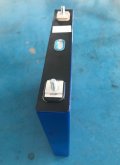
I'm sure we would want a stronger weld because this weld looks very short, not as good of a connection, more resistance. What we're looking for in a BMS is features like active balancing, settings adjustments using a bluetooth iPhone and Android app, like adjustable low temperature charging disconnect, high amp draw disconnect, adjustable battery capacity or voltage ranges, and also fairly higher amp draw capabilities, 120A, 150A or even 200A without using a relay, SSR. We'd like 5 thick wires in and out of the BMS, maybe water resistant or waterproof? Hopefully others can add their opinions.
Here's a picture of a very good Battleborn brand battery cut open with the BMS visible. It has very strong terminals and 5 thick wires in and out of the BMS and many temperature sensors. We would like something like this, because this is what was found by @Will Prowse when he cut it open:
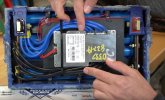
Users like it when it's easier to attach cells together because there's a cap like this with holes so you can easily push a long threaded rod through 4 or 8 cells and just use bolts to hold them together, no tape clamps, and there's air circulation between cells. These are @Will Prowse favorite cell design so far, also because of the plastic insulation caps, strong flat as well as shaped bus bar connections and strong stud connection terminals.
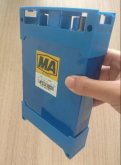
See the simple connection method below:
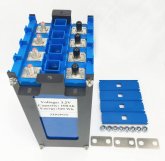
Connection bus bars work flat, but some are also needed that can climb over that long bolt insulator ridge when rows of cell packs are connected sideways.
Some do it like this:

I think for the DIY people, easy and safe connection is the preference. Anyone else with info chime in....
Does this information help?
Your battery pack looks very good however we do like to assemble them ourselves and have more fun DIYing, changing and also replacing bad cells
Is there any way you could laser weld a stud onto the connection terminals like this?

I'm sure we would want a stronger weld because this weld looks very short, not as good of a connection, more resistance. What we're looking for in a BMS is features like active balancing, settings adjustments using a bluetooth iPhone and Android app, like adjustable low temperature charging disconnect, high amp draw disconnect, adjustable battery capacity or voltage ranges, and also fairly higher amp draw capabilities, 120A, 150A or even 200A without using a relay, SSR. We'd like 5 thick wires in and out of the BMS, maybe water resistant or waterproof? Hopefully others can add their opinions.
Here's a picture of a very good Battleborn brand battery cut open with the BMS visible. It has very strong terminals and 5 thick wires in and out of the BMS and many temperature sensors. We would like something like this, because this is what was found by @Will Prowse when he cut it open:

Users like it when it's easier to attach cells together because there's a cap like this with holes so you can easily push a long threaded rod through 4 or 8 cells and just use bolts to hold them together, no tape clamps, and there's air circulation between cells. These are @Will Prowse favorite cell design so far, also because of the plastic insulation caps, strong flat as well as shaped bus bar connections and strong stud connection terminals.

See the simple connection method below:

Connection bus bars work flat, but some are also needed that can climb over that long bolt insulator ridge when rows of cell packs are connected sideways.
Some do it like this:

I think for the DIY people, easy and safe connection is the preference. Anyone else with info chime in....
Does this information help?
NEWYORKHILLBILLY
New Member
- Joined
- May 12, 2020
- Messages
- 136
On BMS the biggest problem we have is finding them with large wires. Put on twice as many large wires as needed!! make sure it has a low temp disconnect. many of us build they for rv . they can be exposed to below freezing temps.
What we're looking for in a BMS is features like active balancing, settings adjustments using a bluetooth iPhone and Android app, like adjustable low temperature charging disconnect, high amp draw disconnect, adjustable battery capacity or voltage ranges, and also fairly higher amp draw capabilities, 120A, 150A or even 200A without using a relay, SSR.
Hi Fish Freak,
Will doesn't believe active balancing is necessary.
I know the batteries should have a BMS and some use their LiFePO4 batteries without them. A properly matched set of cells might never need balancing. Would I use a pack without a BMS? Hell no. I want the extra safety a BMS provides. I thank you for your post as it explains what we are looking for. However I also very much like Peters build examples as this would take a lot of the hassle out of a diy project. Also considering Peters cells are grade A, and I am sure properly matched, I believe it would be rare for a cell to go bad unless of course the pack is abused.
@peter.w
Hi Peter,
I like what Fish Freak is showing you in the example for individual cells and the BMS. I also like your packs with the buss bars welded.
As far as the BMS I can't recommend anything as I have never used one. I have been scratching my head looking at the different ones on the forum...lol. The batteries I use have the BMS built into them. I would like your opinion on active vs. passive balancing. From what I have read and after watching Will's video, passive balancing is fine for our needs. I very much look forward to what you have in mind for a BMS. But as Fish Freak noted it would have to be programmable. And as @NEWYORKHILLBILLY noted it would need to have low temp cut off. Also I don't care for all the thick wires on the battleborn battery. I would prefer to have fewer thick wires and one or two thicker wires. Or even better a bolt on option on the BMS so we could use our own cables..
I really don't know where to go from here. You are intelligent and have a factory so might I suggest everything from individual cells with studs to complete battery builds in cases with BMS? Perhaps offer custom build options using the batteries you have access to? Really interested in seeing more from you. Thanks.
Hi Peter,
I like what Fish Freak is showing you in the example for individual cells and the BMS. I also like your packs with the buss bars welded.
As far as the BMS I can't recommend anything as I have never used one. I have been scratching my head looking at the different ones on the forum...lol. The batteries I use have the BMS built into them. I would like your opinion on active vs. passive balancing. From what I have read and after watching Will's video, passive balancing is fine for our needs. I very much look forward to what you have in mind for a BMS. But as Fish Freak noted it would have to be programmable. And as @NEWYORKHILLBILLY noted it would need to have low temp cut off. Also I don't care for all the thick wires on the battleborn battery. I would prefer to have fewer thick wires and one or two thicker wires. Or even better a bolt on option on the BMS so we could use our own cables..
I really don't know where to go from here. You are intelligent and have a factory so might I suggest everything from individual cells with studs to complete battery builds in cases with BMS? Perhaps offer custom build options using the batteries you have access to? Really interested in seeing more from you. Thanks.
Fish Freak
I fish frequently
Hi Fish Freak,
Will doesn't believe active balancing is necessary.
I know the batteries should have a BMS and some use their LiFePO4 batteries without them. A properly matched set of cells might never need balancing. Would I use a pack without a BMS? Hell no. I want the extra safety a BMS provides. I thank you for your post as it explains what we are looking for. However I also very much like Peters build examples as this would take a lot of the hassle out of a diy project. Also considering Peters cells are grade A, and I am sure properly matched, I believe it would be rare for a cell to go bad unless of course the pack is abused.
You may be right Gazoo about not needing active balancing with new well balanced cells, but in my case, I was thinking, I'm going to short cycle my cells to maximize the cycle life as per Will's video suggestion (and to allow headroom in alternator charging situations, avoid HVD), so my cells may never reach the 3.65v needed for a top balancing bms to go to work. I can always add-on a little active-balancing device that can do it full time, right? Anyone with firsthand experience please share, I'm the new guy just looking at the numbers on paper...
Last edited:
my cells may never reach the 3.65v needed for a top balancing bms to go to work
I have no idea what a top balancing bms is.
The Chargery bms is passive and can be set up to passively balance during any or all of the following:
Charging
Discharging
Storage
You short cycle use has no implications since the passive balance can be working all the time.
Hope that helps.
Fish Freak
I fish frequently
I have no idea what a top balancing bms is.
The Chargery bms is passive and can be set up to passively balance during any or all of the following:
Charging
Discharging
Storage
You short cycle use has no implications since the passive balance can be working all the time.
Hope that helps.
I was not planning on going Chargery, probably just use the popular and less expensive DGJBD because I need many of them, which supposedly doesn't start balancing until the cells reach top charge voltage. Are those little add-on balancers actually considered passive? Lol, the Ali post of course says 'active'...
I was not planning on going Chargery, probably just use the popular and less expensive DGJBD because I need many of them, which supposedly doesn't start balancing until the cells reach top charge voltage. Are those little add-on balancers actually considered passive? Lol, the Ali post of course says 'active'...
Your batteries your choice but it don’t matter how cheap they are if they don’t do what you need ?
peter.w
New Member
- Joined
- May 16, 2020
- Messages
- 34
@Fish Freak @Gazoo @JoeHam @NEWYORKHILLBILLY Hi Bros, what an intensive discussion have been raised. I made some wrap-up in order to move forward correctly.
1. a stud welding on top of positive and negative port: let me check if i can come up with better idea to give more option for DIYer. but first i will make up a outcase so that it looks like a produt .
.
2. BMS:
i am pretty impressed that you think through the questions debated in industry for many years. Active balancing or Passive balancing, it is question. To make it simple, i firstly make a rough conclusion that for battery configuration in such scale (a few kWh even a few tens kWh), Passive balancing is more than enough unless specific requirements are needed. Active balancing will increase the complexity thus decrease the reliability of the overall system, that is why it would be very careful when introducing active balancing. You may look into Tesla's BMS control stradegy, which i take as the best untill now, since it manage a few thoundsands 18650 entirely. The complex BMS hardware and algorithm invloved will be a huge cost for any individuals like DIYer.
back to what we confront now, the BMS used mostly here is so-called protecting board of Li-ion battery, mostly manufacutured by some electrical factory in China. The advantage is they are cheap and easy to get. The BMS used in ESS will be more comlicated than this, but the cost is higher. By drawing an analogy, protecting board is like i3 CPU and BMS is more like i7 or i9 CPU depending on practical application. What i am aiming at, is to find a cost-effective protecting board for the current applicaiton. Pls share with me what you have used with links and suggest what you think is good. e.g. pls put the link of Chargery product for me to evaluate. BMS will also determine the safety level of your system, so be very careful
Cheers
1. a stud welding on top of positive and negative port: let me check if i can come up with better idea to give more option for DIYer. but first i will make up a outcase so that it looks like a produt
2. BMS:
i am pretty impressed that you think through the questions debated in industry for many years. Active balancing or Passive balancing, it is question. To make it simple, i firstly make a rough conclusion that for battery configuration in such scale (a few kWh even a few tens kWh), Passive balancing is more than enough unless specific requirements are needed. Active balancing will increase the complexity thus decrease the reliability of the overall system, that is why it would be very careful when introducing active balancing. You may look into Tesla's BMS control stradegy, which i take as the best untill now, since it manage a few thoundsands 18650 entirely. The complex BMS hardware and algorithm invloved will be a huge cost for any individuals like DIYer.
back to what we confront now, the BMS used mostly here is so-called protecting board of Li-ion battery, mostly manufacutured by some electrical factory in China. The advantage is they are cheap and easy to get. The BMS used in ESS will be more comlicated than this, but the cost is higher. By drawing an analogy, protecting board is like i3 CPU and BMS is more like i7 or i9 CPU depending on practical application. What i am aiming at, is to find a cost-effective protecting board for the current applicaiton. Pls share with me what you have used with links and suggest what you think is good. e.g. pls put the link of Chargery product for me to evaluate. BMS will also determine the safety level of your system, so be very careful
Cheers
@Fish Freak @Gazoo @JoeHam @NEWYORKHILLBILLY Hi Bros, what an intensive discussion have been raised. I made some wrap-up in order to move forward correctly.
1. a stud welding on top of positive and negative port: let me check if i can come up with better idea to give more option for DIYer. but first i will make up a outcase so that it looks like a produt.
2. BMS:
i am pretty impressed that you think through the questions debated in industry for many years. Active balancing or Passive balancing, it is question. To make it simple, i firstly make a rough conclusion that for battery configuration in such scale (a few kWh even a few tens kWh), Passive balancing is more than enough unless specific requirements are needed. Active balancing will increase the complexity thus decrease the reliability of the overall system, that is why it would be very careful when introducing active balancing. You may look into Tesla's BMS control stradegy, which i take as the best untill now, since it manage a few thoundsands 18650 entirely. The complex BMS hardware and algorithm invloved will be a huge cost for any individuals like DIYer.
back to what we confront now, the BMS used mostly here is so-called protecting board of Li-ion battery, mostly manufacutured by some electrical factory in China. The advantage is they are cheap and easy to get. The BMS used in ESS will be more comlicated than this, but the cost is higher. By drawing an analogy, protecting board is like i3 CPU and BMS is more like i7 or i9 CPU depending on practical application. What i am aiming at, is to find a cost-effective protecting board for the current applicaiton. Pls share with me what you have used with links and suggest what you think is good. e.g. pls put the link of Chargery product for me to evaluate. BMS will also determine the safety level of your system, so be very careful
Cheers
Hi Peter,
Thanks for your reply.
The link to Chargery is : http://www.chargery.com/ There is a lot of discussion about Chargery on the forum.
Anyway great discussion here:

Will blasts Chargery
So here it is Will dislikes the Chargery BMS. I don't disagree it's a bit quirky but. He proves how it is fully customizable even if it isn't for him. He does agree that once set up it works fine. I hope everyone who considers buying a Chargery watches this video. I am still a huge fan but...
I just noticed they are offering battery chargers as well as BMS. I don't know anything about Chargery except the BMS requires external relays. If I read correctly users have been complaining about the relays getting hot and high power consumption to the relay coil. Some forum members have found alternative relays that work well with the BMS and there are a couple of users on the forum experimenting with solid state relays. However Chargery has made improvements and from what I can tell users are happy with their BMS. But it is a complicated set up. Always looking forward to your ideas. Thank you.
peter.w
New Member
- Joined
- May 16, 2020
- Messages
- 34
Hi Peter,
Thanks for your reply.
The link to Chargery is : http://www.chargery.com/ There is a lot of discussion about Chargery on the forum.
Anyway great discussion here:

Will blasts Chargery
So here it is Will dislikes the Chargery BMS. I don't disagree it's a bit quirky but. He proves how it is fully customizable even if it isn't for him. He does agree that once set up it works fine. I hope everyone who considers buying a Chargery watches this video. I am still a huge fan but...diysolarforum.com
I just noticed they are offering battery chargers as well as BMS. I don't know anything about Chargery except the BMS requires external relays. If I read correctly users have been complaining about the relays getting hot and high power consumption to the relay coil. Some forum members have found alternative relays that work well with the BMS and there are a couple of users on the forum experimenting with solid state relays. However Chargery has made improvements and from what I can tell users are happy with their BMS. But it is a complicated set up. Always looking forward to your ideas. Thank you.
Chargery locates just byside, i may drop by on site
Cheers
Chargery locates just byside, i may drop by on site
Cheers
And I use the Chargery BMS16T for it’s cell level monitoring, customizable passive balancing, and alarm capabilities.
I run a home office off a 48v 60 Ah battery I built with Fortune cells from electric car parts company. Since I am in the room while the system is in use I personally have no need for relays etc.
I am looking to build or buy another 48v battery and have quotes for individual cells from XUBA and RJ Lithium but I’m watching to see what develops here before deciding.
Similar threads
- Replies
- 27
- Views
- 893
- Replies
- 14
- Views
- 1K
- Replies
- 4
- Views
- 320
- Replies
- 2
- Views
- 166


